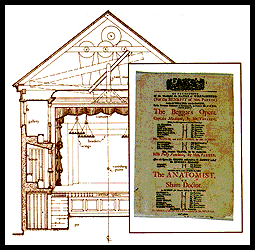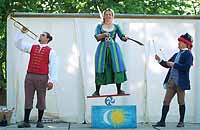Page content
Play Booth Theater

The drawing is a conjectural reconstruction of an 18th-century theater. The original playbill is for The Beggar’s Opera, which was first performed in Williamsburg in 1768. Peter Pelham, organist at Bruton Parish Church, supervised the musical part of the program
- Open-air stage for comedy performances on Palace Green
- American performing tradition inaugurated by William Levingston
- First play in honor of king's birthday
- William & Mary students performed plays in theater
- Second theater constructed behind Capitol near Waller Street
Open-air stage presents 18th-century farces
An open-air stage for Williamsburg Company of Comedians performances, the Play Booth Theater stands on Palace green. There, weather permitting, the troupe presents scenes from 18th-century farces. Play booths like this one popped up in 18th-century Williamsburg for public events on fair days. The company embodies an American performing tradition inaugurated here by merchant William Levingston of neighboring New Kent County.
William Levingston first proprietor of Play Booth
Levingston became the nation's first playhouse proprietor at least in part by virtue of a contract recorded on November 19, 1716. In it, he agreed
"to cause to be erected & built at his own proper Costs and Charge in ye City of Wmsburgh one good substentiall House commodious for acting such Plays as shall be thought fitt to be acted there."
Also parties to the agreement were Levingston's former indentured servants Charles and Mary Stagg. They obligated themselves to perform on his stage and to teach their craft to other aspirants to the boards. In addition, Charles Stagg bound himself to join Levingston in a petition for
"a Patent or a Lycence from ye Governour of Virga for ye sole Priviledge of acting Comedies, Drolls, or other Kind of Stage Plays within any part of ye sd Colony."
First recorded performance in honor of King George I
Governor Alexander Spotswood wrote that he sponsored a performance at Levingston's in honor of the birthday of King George I in 1718, the earliest record of a play in the first theater building on Palace Green.
Archaeological investigation unearthed the foundations of the first theater and showed that the playhouse was 30 feet wide, 86.5 feet long, and at least two stories tall – comparable to English provincial theaters of the day. Archaeological work at the third theater site near the Capitol revealed a much more substantial building.

Levingston out of business by 1727
Levingston was a man who played many parts in his time. A dancing master, he briefly leased a room at the Wren Building. A tavern keeper, he ran an ordinary in his house on the three-lot theater site. He also kept a bowling green. In 1721, however, he mortgaged the properties to Archibald Blair, and by 1727 it appears Levingston was out of business. By the mid 1730s, Dr. George Gilmer Sr. owned the lots and ran an apothecary shop on the corner.
College students performed plays in theater
In 1736, a cast of William and Mary students performed The Tragedy of Cato in the hall, and there were subsequent amateur performances of The Busy Body, The Recruiting Officer, and The Beaux Stratagem. But in 1745, Gilmer sold the playhouse to a public-spirited group of subscribers for £50 to be used as the city hall and the municipal court. Bids for the building's renovation were solicited in the Virginia Gazette that December 19. Nine years later, Gilmer was elected mayor and was once again in charge of the building.
Levingston's playhouse torn down following courthouse construction
Williamsburg's second theater opened by 1752 behind the Capitol near Waller Street. Levingston's playhouse was razed after construction of the Courthouse on Market Square. In 1788, his house was moved around the corner and became part of the St. George Tucker House. The reconstructed Levingston Kitchen – an example of the outbuildings that served his household and now a private residence – adjoins the Play Booth Theater.
